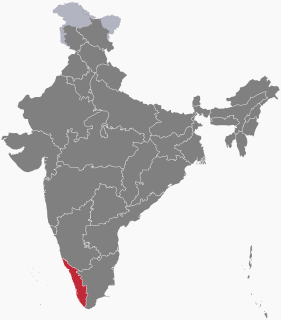
Malayalam is a Dravidian language spoken in the Indian state of Kerala and the union territories of Lakshadweep and Puducherry by the Malayali people. It is one of 22 scheduled languages of India. Malayalam was designated a "Classical Language of India" in 2013. Malayalam has official language status in Kerala, Lakshadweep and Puducherry (Mahé), and is spoken by 34 million people in India. Malayalam is also spoken by linguistic minorities in the neighbouring states; with significant number of speakers in the Kodagu and Dakshina Kannada districts of Karnataka, and Kanyakumari, district of Tamil Nadu. It is also spoken by the Malayali Diaspora worldwide, especially in the Persian Gulf countries, due to large populations of Malayali expatriates there. There are significant population in each cities in India including Mumbai, Bengaluru, Delhi, Kolkata, Pune etc.

The Rāmāyana is a Sanskrit epic from ancient India. Ramayana is one of the two important legends of Hinduism, known as the Itihasas, the other being the Mahābhārata. The epic, traditionally ascribed to the Maharishi Valmiki, narrates the life of Rama, a legendary prince of Ayodhya city in the kingdom of Kosala. The epic follows his fourteen-year exile to the forest urged by his father King Dasharatha, on the request of Rama's stepmother Kaikeyi; his travels across forests in the Indian subcontinent with his wife Sita and brother Lakshmana, the kidnapping of Sita by Ravana – the king of Lanka, that resulted in war; and Rama's eventual return to Ayodhya to be crowned king amidst jubilation and celebration.

In Hinduism, Ahalya also known as Ahilya, is the wife of the sage Gautama Maharishi. Many Hindu scriptures say that she was seduced by Indra, cursed by her husband for infidelity, and liberated from the curse by Rama.
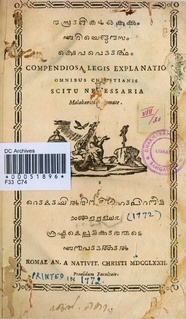
Malayalam, the lingua franca of the Indian state of Kerala and the union territories of Lakshadweep and Puduchery, is one of the six Classical languages of India. Malayalam literature comprises those literary texts written in Malayalam, a South-Dravidian language spoken in the Indian state of Kerala. The first travelogue in any Indian language is the Malayalam Varthamanappusthakam, written by Paremmakkal Thoma Kathanar in 1785. Malayalam literature has been presented with 6 Jnanapith awards, the second-most for any Dravidian language and the third-highest for any Indian language.

Valmiki is celebrated as the harbinger-poet in Sanskrit literature. The epic Ramayana, dated variously from the 5th century BCE to first century BCE, is attributed to him, based on the attribution in the text itself. He is revered as Ādi Kavi, the first poet, author of Ramayana, the first epic poem.

In Hindu, Vanara are either monkeys, or a race of forest dwelling people.

Thunchaththu Ramanujan Ezhuthachan was a Malayalam devotional poet, translator and linguist from Kerala, south India.He was one of the members of the Pracheena Kavithrayam. He has been called the "Father of Modern Malayalam", or, alternatively, the "Father of Modern Malayalam Literature", or the "Primal Poet in Malayalam". He was one of the pioneers of a major shift in Kerala literary production. The number and circulation of his texts far outdo that of any other poet of premodern Kerala.
The Niranam poets, also known as the Kannassan poets, were three poets from the same family by the names of Madhava Panikkar, Sankara Panikkar, and Rama Panikkar. They hailed from Niranam, a small village in southern Kerala, India, near the town of Thiruvalla. Their works mainly comprised translation and adaptation of Sanskrit epics and Puranic works and were for devotional purposes. They lived between 1350 and 1450 C.E.

Shambuka is an interpolated character in Valmiki Ramayana. According to the story, Shambuka, a shudra ascetic, was killed by Rama for attempting to perform tapas in violation of dharma, the bad karma resulting from which caused the death of a Brahmin's son.
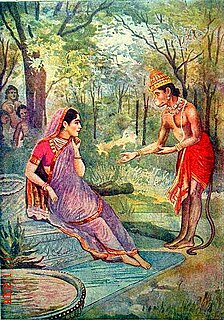
Sundara Kaanda (IAST: Sundara Kāṇḍa, Sanskrit: सुन्दरकाण्ड {beautiful episode}, is the fifth book in the Hindu epic, the Ramayana. The original Sundara Kanda is in Sanskrit and was composed by Valmiki, who was the first to scripturally record the Ramayana. Sundara Kanda is the only chapter of the Ramayana in which the principal protagonist is not Rama, but rather Hanuman. The work depicts the adventures of Hanuman and his selflessness, strength, and devotion to Rama are emphasized in the text. Hanuman was fondly called “Sundara” by his mother Anjani and Sage Valmiki chose this name over others as the Sundara Kanda is about Hanuman's journey to Lanka.
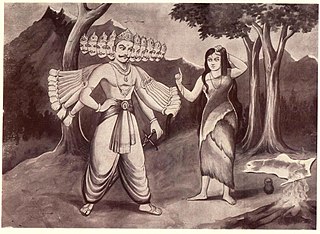
In Hindu mythology, Vedavati was the previous birth of the goddess Sita. She was an avatar of the goddess of prosperity, Lakshmi.

Adhyatma Ramayana is a 13th- to 15th-century Sanskrit text that allegorically interprets the story of Hindu epic Ramayana in the Advaita Vedanta framework. It is embedded in the latter portion of Brahmānda Purana, and the author is considered to be Veda Vyasa. The Hindu tradition also attributes the text to the Bhakti movement saint Ramananda.

Attoor Ravi Varma was an Indian poet and translator of Malayalam literature. One of the pioneers of modern Malayalam poetry, Ravi Varma is a recipient of Kendra Sahitya Akademi Award, Kerala Sahitya Akademi Award for Poetry and Kerala Sahitya Akademi Award for Translation, besides many other honours. The Government of Kerala honoured him with their highest literary award, the Ezhuthachan Puraskaram, in 2012 and the Kerala Sahitya Akademi inducted him as their distinguished fellow in 2017.

Depending on the methods of counting, as many as three hundred versions of the Indian Hindu epic poem, the Ramayana, are known to exist. The oldest version is generally recognized to be the Sanskrit version attributed to the sage Narada, the Mula Ramayana. Narada passed on the knowledge to Valmiki, who authored Valmiki Ramayana, the present oldest available version of Ramayana.

In the Hindu epic Ramayana, Tara is the Queen of Kishkindha and wife of the monkey (vanara) King Vali. After being widowed, she becomes the Queen of Sugriva, Vali's younger brother.
Cherusseri Namboothiri is a 15th-century Malayalam poet who belonged to Kolathunadu, in present-day North Malabar region of Kerala. He was a court poet of Udaya Varma (1446–1475) and the author of Krishnagatha, a poem which is considered a landmark in the development of Malayalam literature.

Rama, Ram, Raman or Ramar, also known as Ramachandra, is a major deity in Hinduism. He is the seventh and one of the most popular avatars of Vishnu. In Rama-centric traditions of Hinduism, he is considered the Supreme Being.
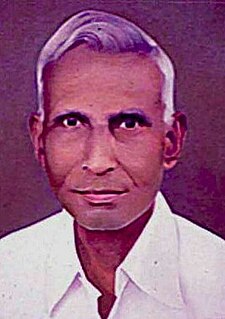
Kudiyirikkal Narayanan Ezhuthachan, commonly known as Dr.K.N.Ezhuthachan was an Indian writer and scholar of Malayalam literature. He was one among the principal followers of the idea of social impact on literature. Ezhuthachan supported Marxist literary criticism and interpreted Indian literary works based on Marxist aesthetics. He won the Sahitya Akademi Award for his work Keralodayam, a long narrative poem written in Sanskrit. He is the first Malayali to win Sahitya Akademi Award in sanskrit literature. He died on 28 October 1981 while delivering a lecture at Calicut University.

Kanchana Sita is a 1977 Indian Malayalam feature-length film scripted and directed by G. Aravindan. A mythological film, its story was adapted from C. N. Sreekantan Nair's play of the same name, which is a reworking of Valmiki's Ramayana.
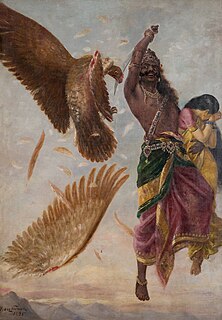
In some adaptations of the Hindu epic Ramayana, Maya Sita or Chaya Sita is the illusionary duplicate of the goddess Sita, who is abducted by the demon-king Ravana of Lanka instead of the real Sita.




















